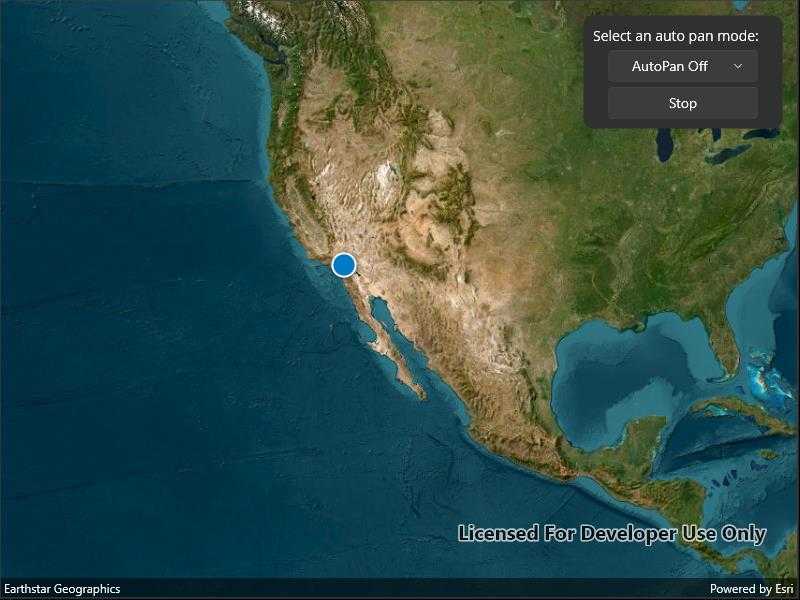Display your current position on the map, as well as switch between different types of auto pan modes.

Use case
When using a map within a GIS, it may be helpful for a user to know their own location within a map, whether that's to aid the user's navigation or to provide an easy means of identifying/collecting geospatial information at their location.
How to use the sample
Select an autopan mode, then use the button to start and stop location display.
How it works
- Create a
MapView. - Set the
LocationDisplay.AutoPanModethat corresponds with the selected element of the combo box. - Set the
LocationDisplay.IsEnabledbool from theMapViewto true. - Set the
LocationDisplay.IsEnabledbool from theMapViewto false when the stop button is pressed.
Relevant API
- LocationDisplay
- LocationDisplay.AutoPanMode
- Map
- MapView
Additional information
Location permissions are required for this sample.
Tags
compass, GPS, location, map, mobile, navigation
Sample Code
// Copyright 2022 Esri.
//
// Licensed under the Apache License, Version 2.0 (the "License"); you may not use this file except in compliance with the License.
// You may obtain a copy of the License at: http://www.apache.org/licenses/LICENSE-2.0
//
// Unless required by applicable law or agreed to in writing, software distributed under the License is distributed on an
// "AS IS" BASIS, WITHOUT WARRANTIES OR CONDITIONS OF ANY KIND, either express or implied. See the License for the specific
// language governing permissions and limitations under the License.
using Esri.ArcGISRuntime.Mapping;
using Esri.ArcGISRuntime.UI;
using Microsoft.Maui.ApplicationModel;
using System.ComponentModel;
using System.Diagnostics;
using Map = Esri.ArcGISRuntime.Mapping.Map;
namespace ArcGIS.Samples.DisplayDeviceLocation
{
[ArcGIS.Samples.Shared.Attributes.Sample(
name: "Display device location with autopan modes",
category: "Location",
description: "Display your current position on the map, as well as switch between different types of auto pan modes.",
instructions: "Select an autopan mode, then use the button to start and stop location display.",
tags: new[] { "GPS", "compass", "location", "map", "mobile", "navigation" })]
public partial class DisplayDeviceLocation : ContentPage, IDisposable
{
// Dictionary to store the different auto pan modes.
private readonly Dictionary<string, LocationDisplayAutoPanMode> _autoPanModes = new()
{
{ "AutoPan Off", LocationDisplayAutoPanMode.Off },
{ "Re-Center", LocationDisplayAutoPanMode.Recenter },
{ "Navigation", LocationDisplayAutoPanMode.Navigation },
{ "Compass", LocationDisplayAutoPanMode.CompassNavigation }
};
public DisplayDeviceLocation()
{
InitializeComponent();
Initialize();
}
private void Initialize()
{
// Create new Map with basemap.
var myMap = new Map(BasemapStyle.ArcGISImageryStandard);
// Assign the map to the MapView.
MyMapView.Map = myMap;
// Populate the picker with different auto pan modes.
AutoPanModePicker.ItemsSource = _autoPanModes.Keys.ToList();
// Keep listening to MapView property changed events until the location display has been initialized.
MyMapView.PropertyChanged += MyMapView_PropertyChanged;
}
private void MyMapView_PropertyChanged(object sender, PropertyChangedEventArgs e)
{
// The map view's location display is initially null, so check for a location display property
// change before subscribing to auto pan mode change events.
if (e.PropertyName == nameof(LocationDisplay))
{
// Show in the UI that LocationDisplay.AutoPanMode is off by default.
AutoPanModePicker.SelectedItem = "AutoPan Off";
// Update the UI when the user pans the view, disabling the auto pan mode.
MyMapView.LocationDisplay.AutoPanModeChanged += (sender, args) =>
{
if (MyMapView.LocationDisplay.AutoPanMode == LocationDisplayAutoPanMode.Off)
{
AutoPanModePicker.SelectedItem = "AutoPan Off";
}
};
// No longer a need to listen for MapView property changes, just listen for auto pan mode changes.
MyMapView.PropertyChanged -= MyMapView_PropertyChanged;
}
}
private void AutoPanModePicker_SelectedIndexChanged(object sender, EventArgs e)
{
// Change the auto pan mode based on the new selection.
MyMapView.LocationDisplay.AutoPanMode = _autoPanModes[AutoPanModePicker.SelectedItem.ToString()];
}
private async void StartStopButton_Clicked(object sender, EventArgs e)
{
try
{
// Start or stop the location display data source.
if (MyMapView.LocationDisplay.IsEnabled)
{
await MyMapView.LocationDisplay.DataSource.StopAsync();
}
else
{
// Request access to device location.
// When deploying to Android, iOS, and MacCatalyst, a permission prompt may appear.
PermissionStatus status = await Permissions.RequestAsync<Permissions.LocationWhenInUse>();
// Start the location display if access to device location has been authorized.
// Permission status will be restricted if the user approximates the device location.
if (status == PermissionStatus.Granted || status == PermissionStatus.Restricted)
{
await MyMapView.LocationDisplay.DataSource.StartAsync();
}
}
}
catch (Exception ex)
{
// Note for MacCatalyst: while on ethernet, without an external GPS device connected,
// location will be unknown.
Debug.WriteLine(ex);
await Application.Current.MainPage.DisplayAlert("Error", ex.Message, "OK");
}
finally
{
// Flip the button text if the LocationDisplay.IsEnabled property was changed.
// Button text won't change if start button was pressed but location access wasn't authorized.
StartStopButton.Text = MyMapView.LocationDisplay.IsEnabled ? "Stop" : "Start";
}
}
public void Dispose()
{
// Stop the location data source.
MyMapView.LocationDisplay?.DataSource?.StopAsync();
}
}
}